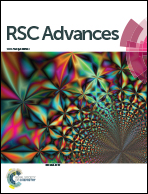Full picture of the thermotropic phase behavior of cardiolipin bilayer in water: identification of a metastable subgel phase
Abstract
The formation of a stable crystalline phase from a fluid phase usually involves the passage through a gel or metastable subgel phase during cooling. Herein, we found for the first time that for the four-tailed lipid, tetramyristoyl cardiolipin (TMCL), a metastable subgel phase (“subgel II”-type phase, or SGII) was formed upon cooling from the gel phase, and such a metastable subgel phase served as the precursor towards the formation of a stable crystalline phase. A detailed thermotropic, X-ray diffraction and infrared spectroscopic study was carried out to study the formation of the subgel and crystalline phases, along with a comparison of the gel and fluid phases. All the four phases (crystalline, subgel, gel and fluid) are lamellar structured and the interlamellar spacings of the gel and fluid phases swell as the water content increases in pure water. A full picture of the thermotropic phase behavior of TMCL in water was obtained and it was found that the transformations between fluid–gel and gel–subgel are reversible, while the phase transformation processes involving the crystalline phase are irreversible. The gel to subgel transition mainly involves the reorganization of the tail packing state (from hexagonal to orthorhombic), and this phase transition was found to be independent of solvent. Changing from subgel to crystalline phase needs a long incubation time at relatively low temperatures (0–5 °C), and this crystalline phase converts to a gel phase upon heating. The present work sheds light on the crystallization process of amphiphiles and has profound implications on the stability of cardiolipin-based model systems or supramolecular self-assembly systems.


 Please wait while we load your content...
Please wait while we load your content...